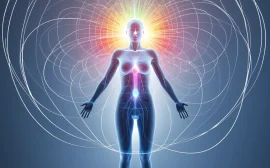Every photon that strikes your retina carries more than just visual information—it contains instructions that reprogram your cellular machinery at the molecular level. The discovery that non-visual photoreceptors in our eyes directly control everything from insulin sensitivity to mitochondrial biogenesis has revolutionized our understanding of metabolism. We’re not simply organisms that happen to respond to light; we’re biological machines whose operating systems are fundamentally controlled by specific electromagnetic wavelengths, with blue light (480-500 nanometers) acting as a master regulatory signal that evolution never anticipated would dominate our visual environment.
The modern photonic environment represents an unprecedented experiment in human biology. For roughly 300,000 years of homo sapiens evolution, blue light exposure followed predictable patterns: intense during midday, filtered through atmospheric Rayleigh scattering at dawn and dusk, and completely absent at night. Our metabolic machinery evolved exquisite sensitivity to these patterns, using blue light as a temporal landmark to synchronize thousands of cellular processes. Today’s artificial lighting and screen-dominated environment delivers blue light at intensities and times that scramble these ancient programs, creating what researchers term “circadian disruption syndrome”—a state where our cellular clocks run different times, like a distributed computer system with failed time synchronization.
The Molecular Machinery: Melanopsin and the Non-Visual Opsins
The story of metabolic light regulation begins not with the familiar rods and cones, but with intrinsically photosensitive retinal ganglion cells (ipRGCs) containing melanopsin, a photopigment that responds maximally to 480nm blue light. These cells, comprising less than 2% of retinal ganglion cells, wield disproportionate influence over our physiology. When blue photons strike melanopsin, they trigger a conformational change from 11-cis-retinal to all-trans-retinal, initiating a G-protein cascade that ultimately depolarizes the cell. This isn’t mere signal transduction—it’s the beginning of a biological program that affects every cell in your body.
The melanopsin system exhibits what physicists call “photon integration”—it counts photons over time rather than responding to instantaneous intensity. This temporal integration, occurring over periods of several minutes, makes the system exquisitely sensitive to chronic low-level exposure, exactly what screens deliver. A smartphone at typical viewing distance delivers approximately 40-80 lux of blue-enriched light directly to the retina. While this seems minimal compared to outdoor illumination (10,000-100,000 lux), the spectral power distribution peaks precisely at melanopsin’s absorption maximum, creating what photobiologists term “melanopic equivalent daylight illumination” far exceeding what the raw lux values suggest.
Recent discoveries have identified melanopsin expression beyond the eye—in blood vessels, brain tissue, and even adipocytes. This peripheral melanopsin system responds to blue light that penetrates tissue, with approximately 1-2% of blue photons reaching subcutaneous depths. These peripheral photoreceptors appear to coordinate local circadian rhythms, creating what systems biologists call “distributed temporal control.” Your fat cells, quite literally, can detect whether you’re looking at your phone at midnight.
The Metabolic Cascade: From Photon to Glucose Metabolism
The pathway from blue light exposure to metabolic dysfunction follows multiple interconnected routes. The primary pathway runs through the suprachiasmatic nucleus (SCN), the master circadian clock, which uses blue light information to synchronize peripheral clocks in the liver, pancreas, and adipose tissue. These peripheral clocks control the rhythmic expression of metabolic genes—up to 50% of the liver’s transcriptome oscillates in a circadian manner, including crucial genes for glucose metabolism, lipogenesis, and cholesterol synthesis.
Blue light exposure at night suppresses melatonin, but the metabolic consequences extend far beyond sleep disruption. Melatonin functions as a powerful metabolic regulator, enhancing insulin sensitivity through multiple mechanisms. It upregulates GLUT4 translocation in muscle cells, increases adiponectin secretion from adipocytes, and reduces hepatic gluconeogenesis. When blue light suppresses nighttime melatonin, insulin resistance increases measurably within days. Continuous glucose monitoring studies show that identical meals produce 20-30% higher glucose excursions when preceded by two hours of blue light exposure compared to dim red light.
The acute metabolic effects are equally striking. Blue light exposure triggers immediate cortisol release, even in the absence of psychological stress. This photo-induced cortisol follows different kinetics than stress-induced release—a sustained elevation lasting 2-3 hours rather than the typical 30-minute spike. This prolonged cortisol elevation activates hormone-sensitive lipase, flooding the bloodstream with free fatty acids that compete with glucose for cellular uptake, a phenomenon called the Randle cycle. Simultaneously, cortisol stimulates hepatic glucose output through enhanced gluconeogenesis, creating a perfect storm of metabolic dysfunction: elevated glucose, elevated fatty acids, and decreased glucose uptake.
The Mitochondrial Impact: Photonic Disruption of Cellular Energetics
Perhaps nowhere is blue light’s metabolic impact more profound than in mitochondrial function. Mitochondria maintain their own circadian rhythms, with rhythmic fission and fusion cycles that optimize energy production for anticipated metabolic demands. Blue light exposure at inappropriate times disrupts these cycles, leading to what researchers term “mitochondrial chronodisruption.” Electron microscopy reveals dramatic morphological changes: mitochondria exposed to mistimed blue light show fragmentation, cristae disorganization, and accumulation of damaged proteins that would normally be cleared during the nocturnal fusion phase.
The mechanism involves NAD+ metabolism, the crucial cofactor for cellular energy production. The NAD+ salvage pathway, controlled by the enzyme NAMPT, follows a strict circadian rhythm, peaking during the active phase to support energy metabolism. Blue light at night phase-shifts NAMPT expression, creating a state of relative NAD+ deficiency when cells need it most. This NAD+ deficit cascades through metabolism: decreased SIRT1 activity impairs mitochondrial biogenesis, reduced PARP1 function compromises DNA repair, and diminished CD38 activity disrupts calcium homeostasis.
Complex I of the electron transport chain shows particular vulnerability to blue light disruption. Proteomics studies reveal that nighttime blue light exposure decreases Complex I subunit expression by up to 35%, reducing the mitochondria’s ability to generate ATP efficiently. This forces cells to rely more heavily on glycolysis, a less efficient energy pathway that produces lactate as a byproduct. The resulting metabolic shift—from oxidative phosphorylation to aerobic glycolysis—resembles the Warburg effect seen in cancer cells, raising troubling questions about long-term disease risk.
The Adipose Tissue Response: Light as a Lipogenic Signal
Adipose tissue, once considered passive energy storage, emerges as a primary target of blue light’s metabolic effects. Adipocytes express their own circadian clocks, controlling the rhythmic release of adipokines like leptin and adiponectin that regulate whole-body metabolism. Blue light exposure disrupts these adipocyte clocks through what researchers call “photic adipose reprogramming,” fundamentally altering how fat cells store and release energy.
The lipogenic response to blue light follows fascinating quantum mechanical principles. When blue photons interact with flavin-containing enzymes in adipocytes, they can trigger electron spin changes that alter enzyme activity—a phenomenon called the “cryptochrome magnetoreception mechanism.” This quantum effect appears to enhance fatty acid synthase activity, promoting de novo lipogenesis even in the absence of excess calories. Adipocytes exposed to blue light show 40% increased triglyceride accumulation compared to controls, independent of insulin signaling.
Brown adipose tissue (BAT), crucial for thermogenesis and metabolic health, shows particular sensitivity to blue light disruption. BAT mitochondria contain high levels of uncoupling protein 1 (UCP1), which generates heat by dissipating the mitochondrial proton gradient. Blue light exposure suppresses UCP1 expression through disruption of the PRDM16-PGC1α transcriptional complex, reducing BAT’s capacity for non-shivering thermogenesis. This decreased thermogenic capacity means fewer calories burned at rest, contributing to positive energy balance even without increased food intake.
The Hormonal Symphony: Endocrine Disruption Through Photonic Pathways
The endocrine system operates as a carefully choreographed temporal symphony, with hormone release patterns optimized for metabolic efficiency. Blue light acts like a rogue conductor, disrupting this temporal organization across multiple hormonal axes. The hypothalamic-pituitary-thyroid axis shows particular vulnerability: nighttime blue light suppresses TSH release and reduces T3 to T4 conversion, creating a state of functional hypothyroidism that decreases metabolic rate by 5-8%.
Growth hormone, crucial for metabolic health and body composition, normally peaks during early sleep in response to slow-wave sleep and low glucose levels. Blue light exposure delays and blunts this growth hormone surge through multiple mechanisms: direct suppression via SCN projections to growth hormone-releasing hormone neurons, indirect suppression through elevated cortisol, and sleep architecture disruption that reduces slow-wave sleep duration. Adults exposed to blue-enriched light in the evening show 50% reduced growth hormone area under the curve compared to those in dim light conditions.
The reproductive hormones exhibit complex responses to blue light that impact metabolism. In males, nighttime blue light suppresses testosterone production by Leydig cells, with levels dropping 20-30% after just one week of evening screen use. Since testosterone promotes muscle protein synthesis and lipolysis, this suppression shifts body composition toward increased fat mass. In females, blue light disrupts the luteinizing hormone surge necessary for ovulation, creating irregular cycles that correlate with insulin resistance and metabolic syndrome risk.



